
1940-09-27
Handley-Page 52 Hampden Mk. B.1 - Serial # P2090
61 Squadron, Hemswell

Color Profile by Torstein Landström
- P/O R.P. Earl, Pilot
- P/O W.D. Hermon, Navigator
- Sgt J.C. Williams, Air Gunner & Wireless Operator
- Sgt D. Sinclair, Air Gunner & Wireless Operator
The first funeral of Commonwealth airmen in Helsingborg
- Written by Rolf Arvidsson -
E-mail: roboar.ny@gmail.com
In summer 1940, after the fall of France and the evacuation from Dunkirk - which is considered to be the greatest disaster in British military history - Britain was in a desperate situation and had at the same time to fight the Battle of Britain. This furious air battle, concerning supremacy of the skies over the English Channel and southern England, has afterwards been dated from 10 July to 31 October. Britain had also to go through the German "Blitz" from 7 September until May 1941.
During these dark days, Britain had to defend its own territory with all the means at their disposal. The Royal Air Force had to take a big responsibility in this fatal struggle. One very important task for the RAF was to bring the war into the heart-land of Nazi Germany. The spear head of this fight was the Bomber Command of the RAF. Compared to the German "Luftwaffe", the British Bomber Command was of less strength, both with regards to quantity and technique. In spring 1940, Bomber Command had tried to attack in daylight, but after huge losses, they had changed to mainly perform raids during the dark hours. Lack of adequate navigational instruments made the bombing results poor. Night bombing in this early stage of the war was mainly performed by Whitley, Wellington and Hampden medium bombers. The heavy four engined bombers entered the scene later in the war.
Some German bombers dropped by mistake bombs over London the night of 24/25 August 1940. As retaliation, Bomber Command dispatched some 50 bombers, mostly Hampdens and Wellingtons, to the first raid on Berlin the following night. No one of these two raids, caused much damage in the two capitals, but it was a clear indication to Germany that they could not be secure in their own Fatherland. The head of "Luftwaffe", Hermann Goering, had before the war stated that no enemy plane could attack Germany. Up till now many raids had been performed by Bomber Command, but this was the first one on Berlin. It was a big loss of prestige for Hermann Goering. At the same time it was extremely important and encouraging to the harassed British home front. Of course both sides exaggerated their own bombing results, and depreciated the raids of the enemy.
The night of 26/27 September 1940, 61. Squadron based in Hemswell northwest of Lincoln, was briefed to attack two targets in Germany with twelve Hampdens. The main target was the battleship Scharnhorst in the harbour of Kiel, where the German navy had big installations. Pilot Officer R. P. Earl, captain of Hampden P2090, was briefed to attack Kiel and Scharnhorst with his aircraft and crew of four airmen, including himself as pilot and "skipper". The twelve Hampdens took off from their base in Hemswell from approximately 20.00 to 20.30 (GMT).
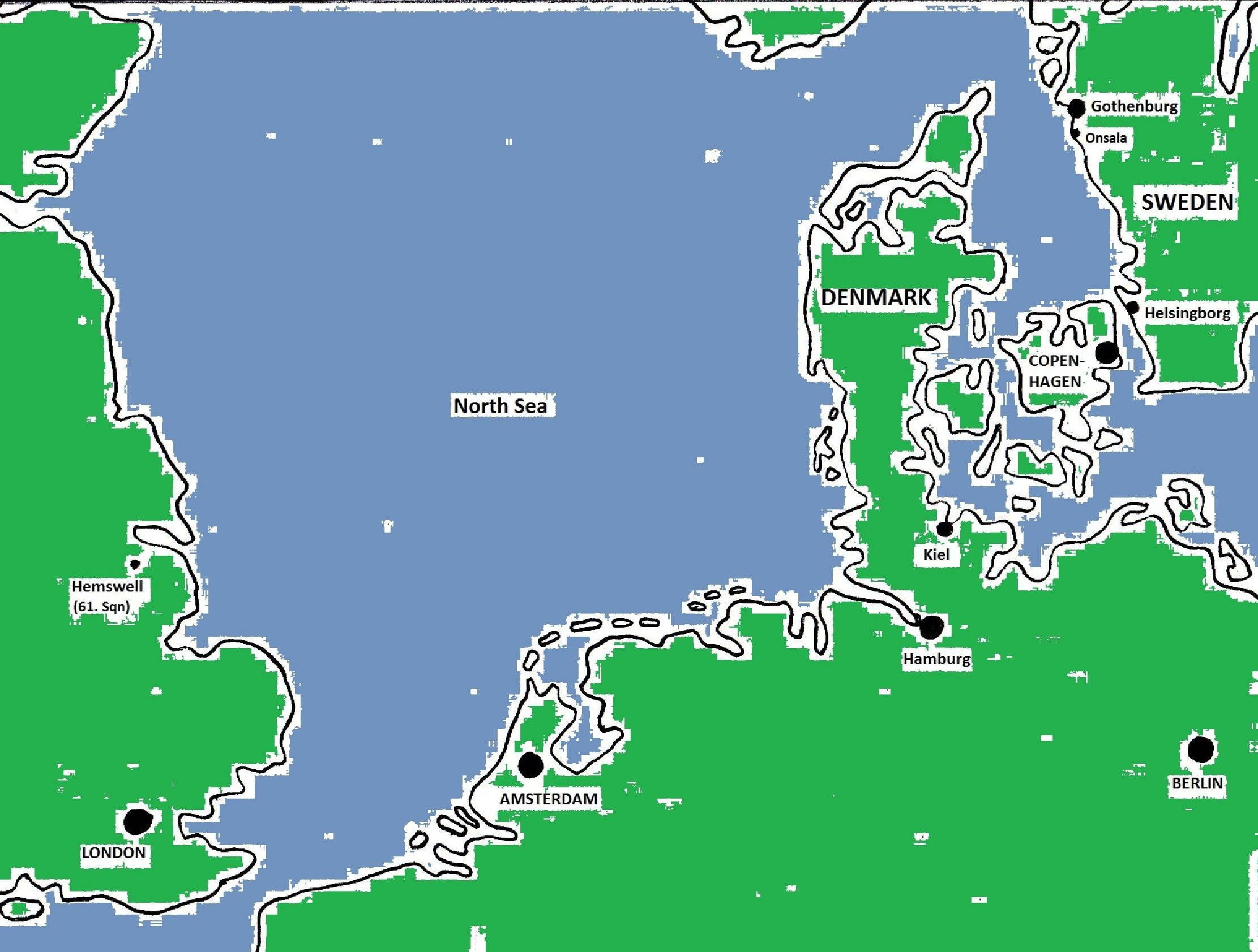
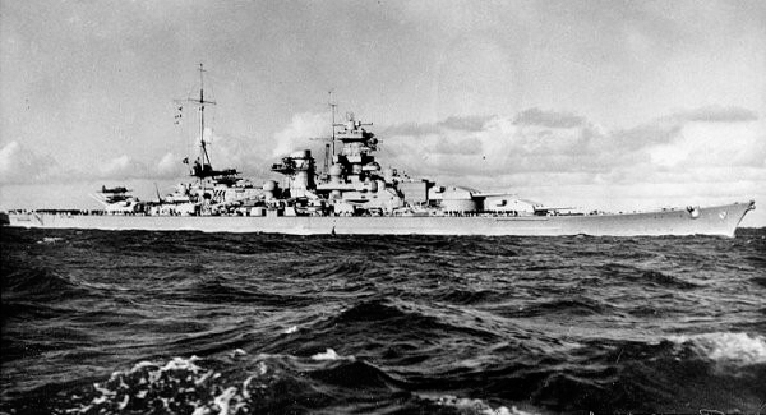
The Battleship Scharnhorst
The weather over Kiel was bad with cloud up to 2000 m. The flak was intense but inaccurate. Bombing results were poor. Probably Scharnhorst was hit only by one bomb. After the attack, the bombers turned north-east and then north over the water between Denmark and Sweden. This straight is called Öresund (The Sound). North of Copenhagen, the German flak batteries opened fire against the roar of Bristol Pegasus engines from the Hampdens. Short afterwards one Hampden crashed in the Sound, close to the Swedish coastline, just south of the town of Helsingborg. It was P2090 piloted by Pilot Officer R. P. Earl. The aircraft had got flak damages, perhaps both from Kiel and north of Copenhagen. The other eleven Hampden bombers from 61. Squadron returned safely to their base in Hemswell.
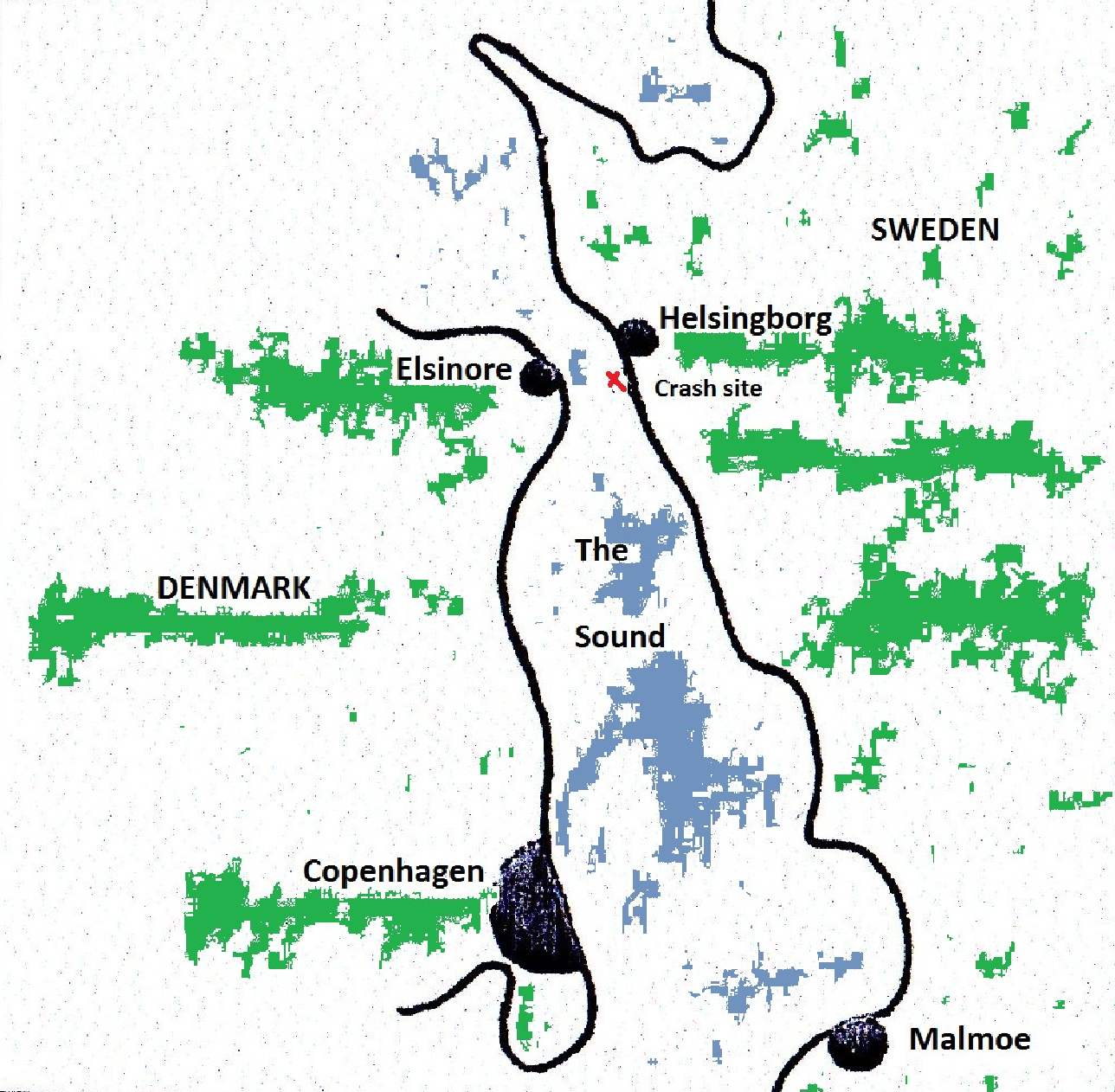
Eyewitnesses had heard the aircraft come in over Swedish territory south of Helsingborg, and then suddenly turn southwards. It lost height and skimmed the waves, switched on a searchlight as trying to find a spot for an emergency landing. The Hampden struck a pole for fishing yarns, and crashed in the water at 00.10 local time (GMT +1), some 400 m from the Swedish coastline. For some moments, a kind of light, maybe an emergency flare, could be seen from the crash site. Then, nothing more could be seen of the aircraft from the coastline. The weather was adverse with strong winds, high waves and poor visibility.
From the local police report, the following facts are extracted and summarized:
An eyewitness had seen the plane crash and went together with another person out in a fishing-boat to the probable spot to rescue survivors. They had problems in reaching the aircraft as it was drifting in the strong winds and high waves. Then they saw the machine disappear down into the water. Any airmen were not visible, but it was hard to overview the area in the darkness. Immediately afterwards an alerted pilot-boat arrived and searched the area with light. It was less than thirty minutes after the crash. They could not find anything, but reported oil spots on the water surface and a strong smell of petrol. An ambulance was also required and was ready to take care of survivors when the pilot-boat returned. An aileron was reported to be found, but the report did not tell if it was in the sea, or if it was washed ashore. An officer with a patrol of eight soldiers searched 2-3 km of the coastline opposite to the crash site without results. At dawn this action was repeated. A fisherman found in the morning what he described as "a crash helmet and other items of equipment" on the beach. From a name in the helmet he thought the airplane was British. He was told to bring his findings to the military authorities.
On Friday morning 26 September, the crash site was examined, though the weather still was windy and the sea turbulent. A big spot of oil was covering the area. A dinghy and a parachute were salvaged. No signs of the crew could be seen. Next day the weather was better, and the wreck of the Hampden was visible on the bottom. The depth was 5 – 7 m.
On Sunday 29 September, divers from the Swedish Navy went down. They examined the wreck and the crash site, but they could not find any signs of the crew or any bombs and other explosives. The aircraft was towed to the harbour of Helsingborg, where it was lifted onto the quay. The squadron code QR-R and the serial No. P2090 were visible. One engine was missing and the bomber showed plain signs of flak damage.
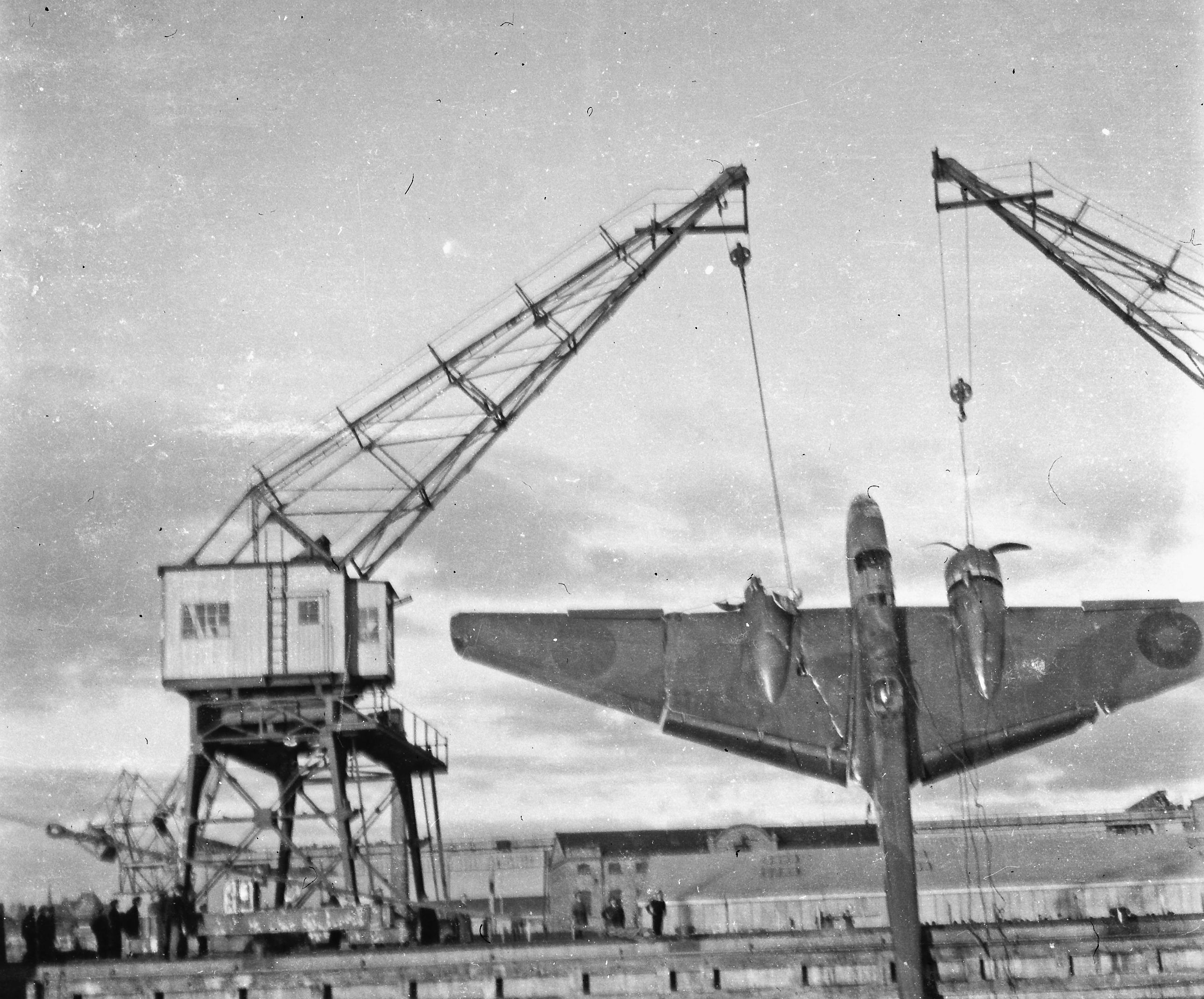
Note the missing port engine. Photo via Magnus Löwenstein
Wednesday 2 October was a calm day with clear water. After thoroughly searching, the body of one crew member was found. He was identified as Pilot Officer W. D. Hermon from South Africa, 22 years and acting as 2nd pilot and navigator. The same day the missing engine was found.
Two days later, the Swedish Navy again dragged on and around the crash site, and two more missing airmen from the Hampden crew were found. They were identified as Sergeant J. C. Williams, 25 years, air gunner and wireless operator, and Sergeant D. Sinclair, 23 years and also acting as air gunner and wireless operator. One of them had a small bible in a pocket of his uniform. Still there were no signs of the 1st pilot and captain of the bomber, Pilot Officer Raymond Patrick Earl, 23 years.
On Monday 7th October, the funeral of the three found men took place at Pålsjö municipal cemetery in Helsingborg. They were buried with military honours. Though rainy weather, also many civilian people from the general public had come to honour the British airmen. The three coffins were wrapped in Union Jack. Six soldiers from the Swedish Navy paraded at each coffin. An orchestra played and a salute was fired by a platoon of 50 soldiers. Both the British and the Swedish national anthems were sung. The funeral was conducted by a British and Swedish clergyman together. This was the first war funeral of British airmen in Helsingborg during the Second World War, but unfortunately not the last one. When the war came to an end in 1945, a total of 47 British airmen had been buried at this cemetery. Today British airmen are also buried in eight other cemeteries in Sweden, and in total there are 99 identified and 14 unidentified airmen in Swedish cemeteries and graveyards. A number of them did not crash in Sweden, but were washed ashore along the Swedish coastline.
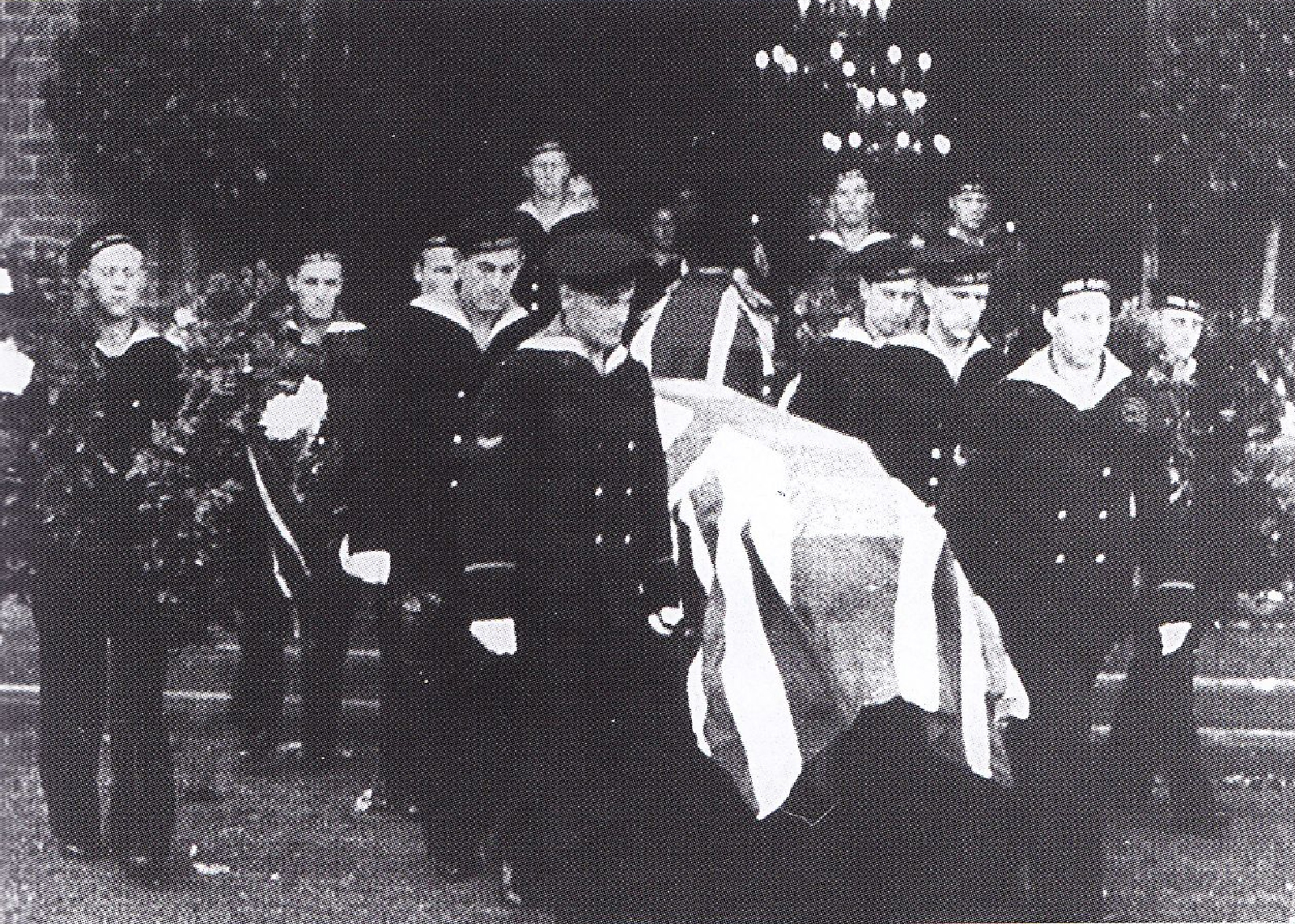
Funeral 07/10/1940. Photo via Widfeldt/Wegmann
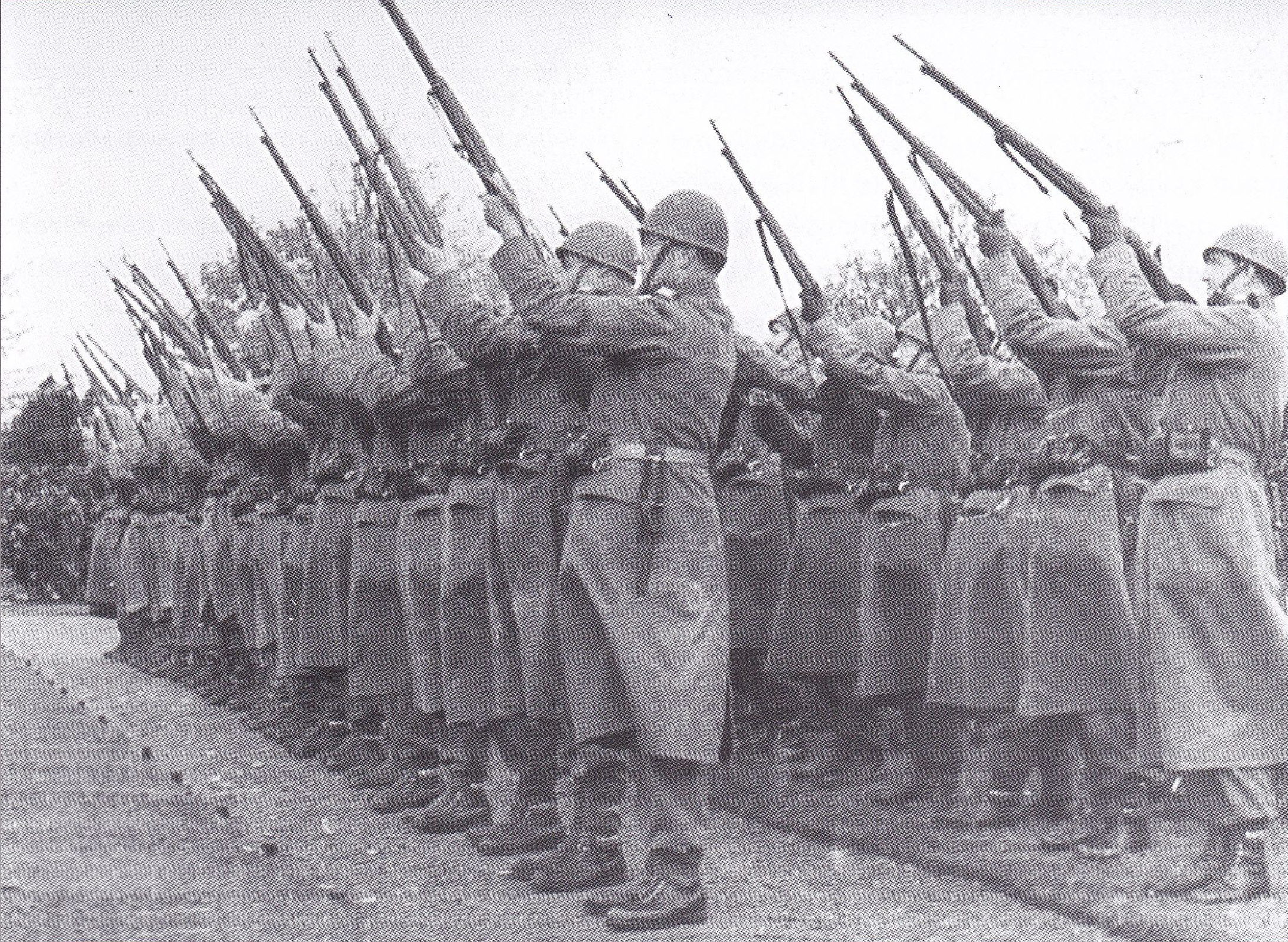
Funeral 07/10/1940. Photo via Widfeldt/Wegmann
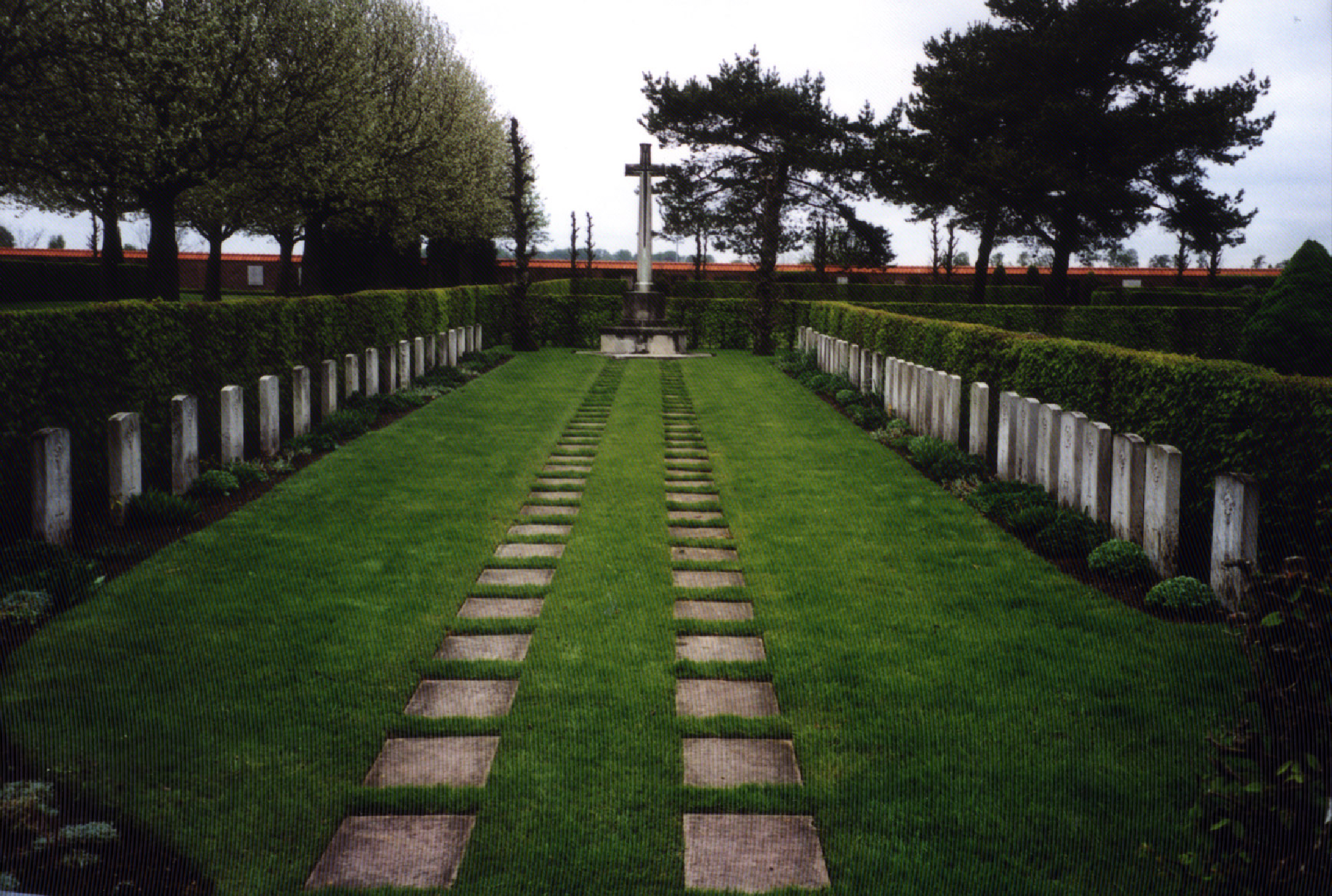
Commonealth War Cemetery in Pålsjö, Helsingborg. Photo of today.
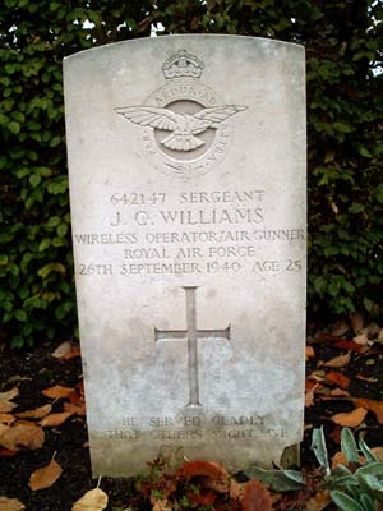
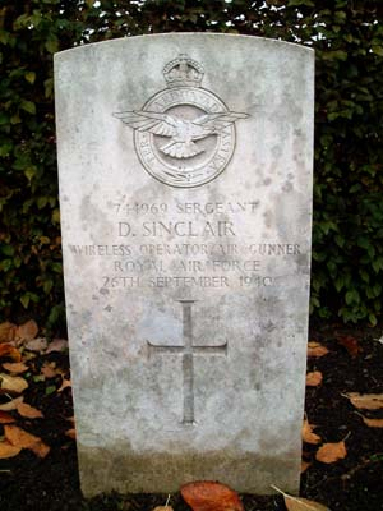
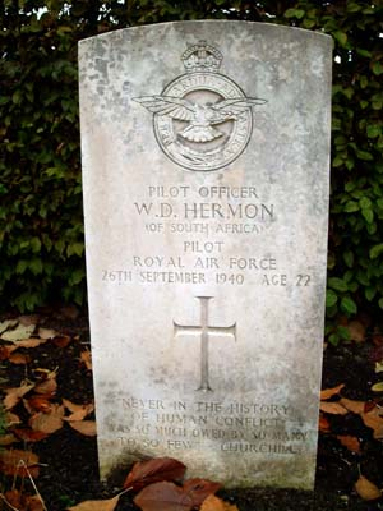
The three tombstones of J.C.Willams, D.Sinclair and W.D.Hermon in Helsingborg
The missing crew member and captain of Hampden P2090, Pilot Officer R. P. Earl, was not found until the end of November - two months after the fatal crash landing. His body had been brought by the sea-currents some 180 km to the north along the Swedish west coast, and was washed ashore at Onsala south of Gothenburg. He was buried at the local church yard at Onsala, but in 1961 his body was moved to the cemetery of Kviberg in Gothenburg, where 38 British airmen are buried. During 1961, the Commonwealth War Graves Commission moved the remains of British soldiers in Sweden from a number of remote places to Kviberg cemetery, to make it easier for relatives to visit the last resting-place of their fallen sons.
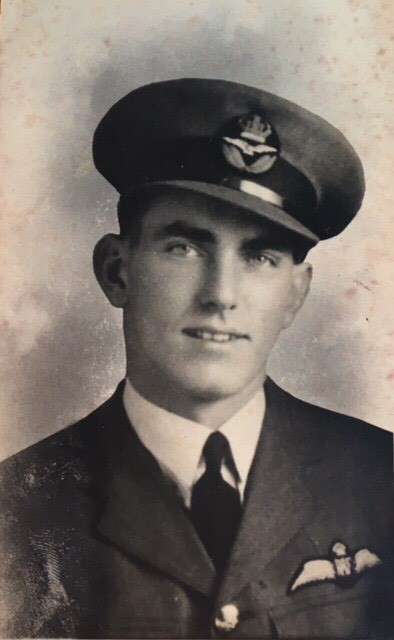
Pilot Officer Raymond Patrick Earl. Photo via Stephen Earl. R. P. Earl was his grandfather's brother.
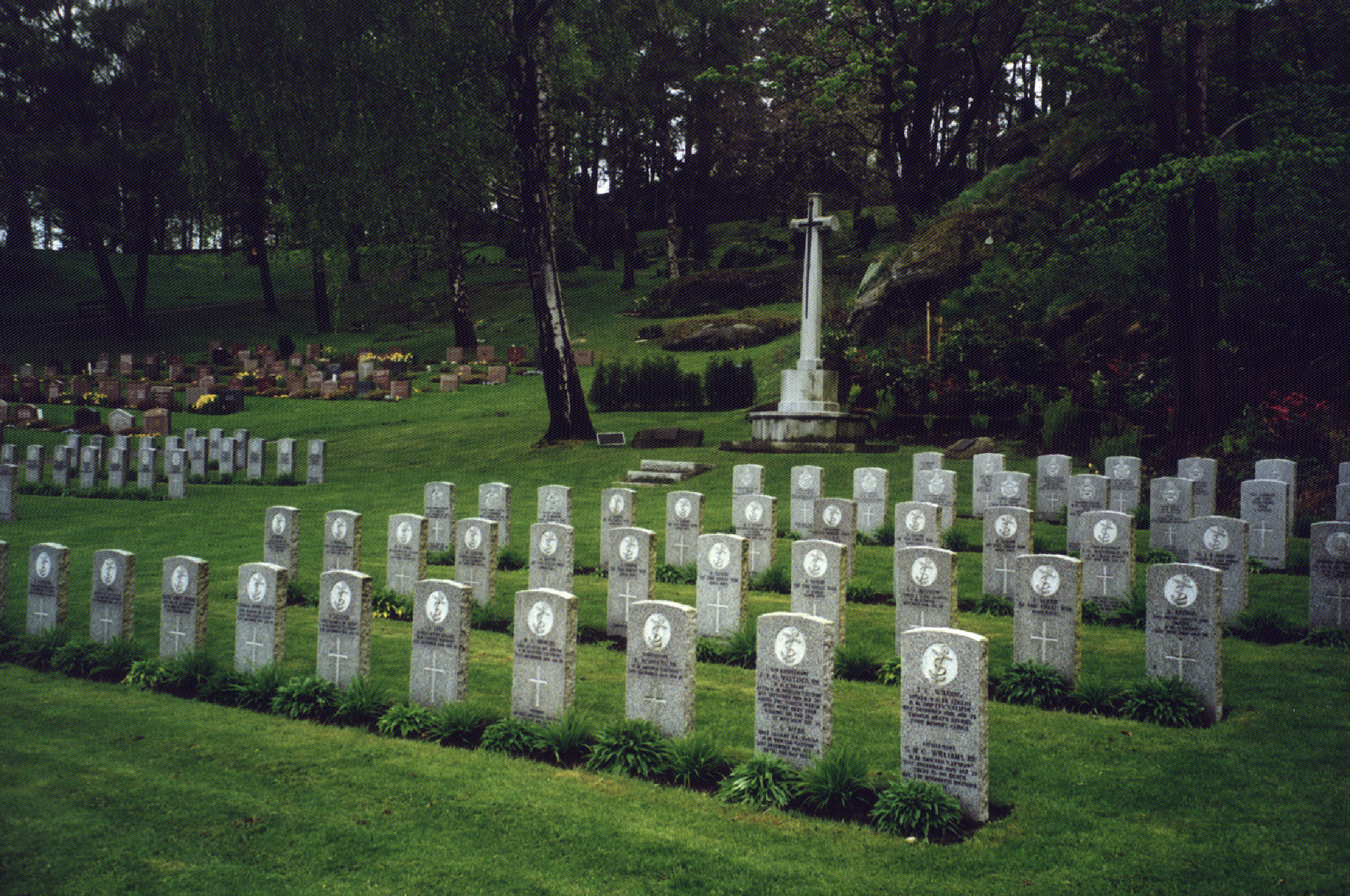
Kviberg cemetery of today in Gothenburg
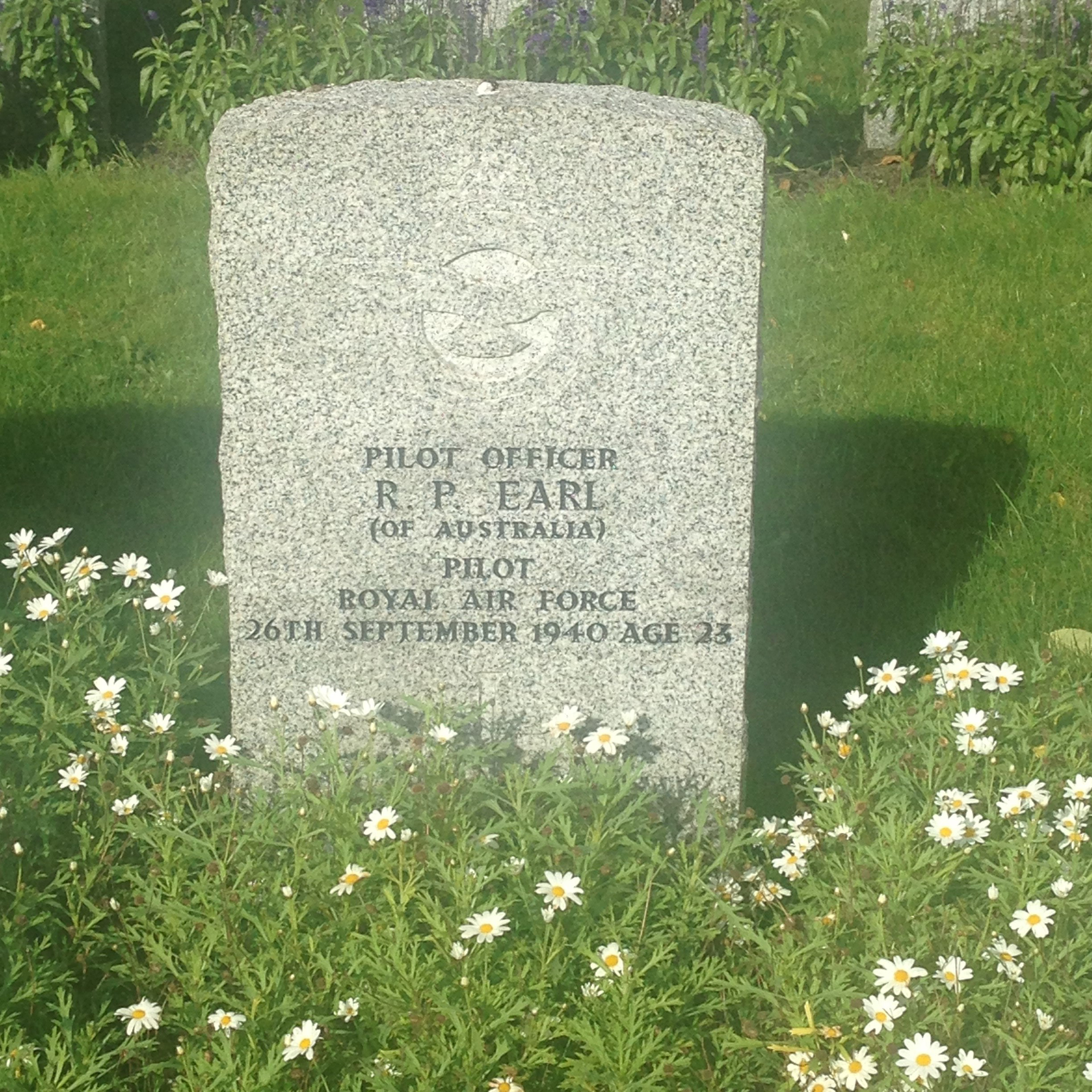
Tombstone of R. P. Earl in Gothenburg. Photo of Joel Karlsson, autumn 2016.
Summary:
Aircraft, unit etc
Serial range P2062-P2100, 39 Hampdens, were part of a batch of 75 Hampdens, which were delivered to Royal Air Force Bomber Command by the English Electric Co. in Preston between February and July 1940. Ten of these 75 bombers were converted to Hampden TB (Torpedo Bomber).
